Opening IIS Manager in Windows 10 is a straightforward process that involves enabling the feature through the Control Panel and then accessing it via the Start menu. By following a few simple steps, you will have IIS Manager up and running quickly.
This section will guide you through the steps to enable and open IIS Manager in Windows 10. By the end, you’ll be able to manage your web server settings directly from your computer.
Step 1: Open Control Panel
Click on the Start menu and type «Control Panel,» then hit Enter.
The Control Panel is where we will enable the IIS feature. Finding it is straightforward: just type it in the Start menu and hit Enter.
Step 2: Go to Programs and Features
In the Control Panel, click on «Programs,» then «Programs and Features.»
Programs and Features is where you will manage the software and features installed on your Windows 10 system.
Step 3: Turn Windows Features On or Off
Click on «Turn Windows features on or off» on the left side.
This will open a new window with a list of Windows features that you can enable or disable.
Step 4: Enable Internet Information Services (IIS)
Scroll down and check the box next to «Internet Information Services.» Click OK.
Checking this box will install the necessary IIS components on your system. It might take a few minutes.
Step 5: Open IIS Manager
Go back to the Start menu, type «IIS Manager,» and hit Enter.
Now that IIS is enabled, you can easily access IIS Manager by typing it into the Start menu.
Once you complete these steps, the IIS Manager will open, allowing you to configure and manage your web server settings.
Tips for Opening IIS Manager in Windows 10
- Ensure Administrative Access: Make sure you are running Windows 10 with administrative privileges to enable and access IIS.
- Use Search Bar: If you can’t find IIS Manager right away, use the search bar in the Start menu.
- Check for Updates: Ensure your Windows 10 is up-to-date to avoid any compatibility issues.
- Restart if Necessary: If IIS Manager doesn’t appear, try restarting your computer.
- Explore IIS Features: Once opened, explore different IIS features to get familiar with its functionalities.
Frequently Asked Questions
What is IIS Manager?
IIS Manager is a tool for managing Internet Information Services, which is a flexible, secure, and manageable web server for hosting anything on the web.
Do I need to restart my computer after enabling IIS?
In most cases, you don’t need to restart your computer. However, if IIS Manager doesn’t show up, a restart might help.
Can I install IIS on any version of Windows 10?
IIS can be installed on Windows 10 Pro, Enterprise, and Education editions, but not on Windows 10 Home edition.
What if IIS Manager is not working properly?
Ensure that all the necessary components are enabled in the Windows Features settings. You may also check for any Windows updates.
Is IIS Manager useful for beginners?
Yes, IIS Manager is user-friendly and a good starting point for beginners interested in web server management.
Summary of How to Open IIS Manager in Windows 10
- Open Control Panel
- Go to Programs and Features
- Turn Windows Features On or Off
- Enable Internet Information Services (IIS)
- Open IIS Manager
Conclusion
Opening IIS Manager in Windows 10 is a manageable task that involves just a few simple steps. By enabling the feature through the Control Panel and accessing it via the Start menu, you can start managing your web server settings in no time. Remember to ensure you have administrative access, keep your system updated, and explore the various features IIS Manager has to offer.
Gaining familiarity with IIS Manager can significantly enhance your web management skills. So, whether you’re a beginner or someone looking to refine their expertise, following this guide will set you on the right track. For further reading, consider exploring Microsoft’s official IIS documentation or community forums for additional tips and tricks. Now, go ahead and give it a try!
Kermit Matthews is a freelance writer based in Philadelphia, Pennsylvania with more than a decade of experience writing technology guides. He has a Bachelor’s and Master’s degree in Computer Science and has spent much of his professional career in IT management.
He specializes in writing content about iPhones, Android devices, Microsoft Office, and many other popular applications and devices.
Read his full bio here.
Одна из самых необходимых вещей, которую веб-разработчики захотят установить в Windows 10 для работы веб сервера – это службы IIS (Internet Information Services) . Подробнее про IIS и его сравнение с Apache, другим популярным веб сервером, можно прочесть в нашей статье.

Установка IIS
На самом деле это даже не установка, как таковая, а включение службы, потому что в Windows 10 этот компонент есть сразу, но он просто выключен.
Первым делом нам нужно нажать комбинацию клавиш Win + R, и после того как появится окно “Выполнить”, нам нужно набрать “appwiz.cpl” и нажать OK. Либо мы просто можем пойти в Панель управления и там выбрать пункт Программы – Программы и компоненты – Установка и удаление программ.

Тут нам нужно выбрать пункт “Включение или отключение компонентов Windows”.

Тут находим пункт “Службы IIS”, ставим на против него галочку и нажимаем ОК, после чего служба будет включена.
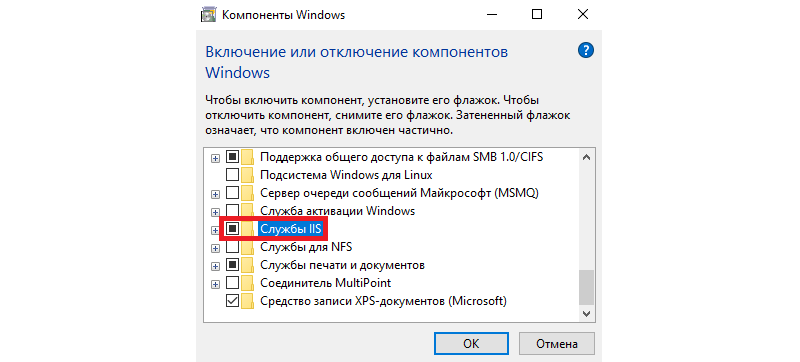
Если вам, как разработчику, нужны дополнительные параметры, то мы можете раскрыть этот пункт, нажав на плюсик, и включить или отключить те функции, которые вам необходимы.
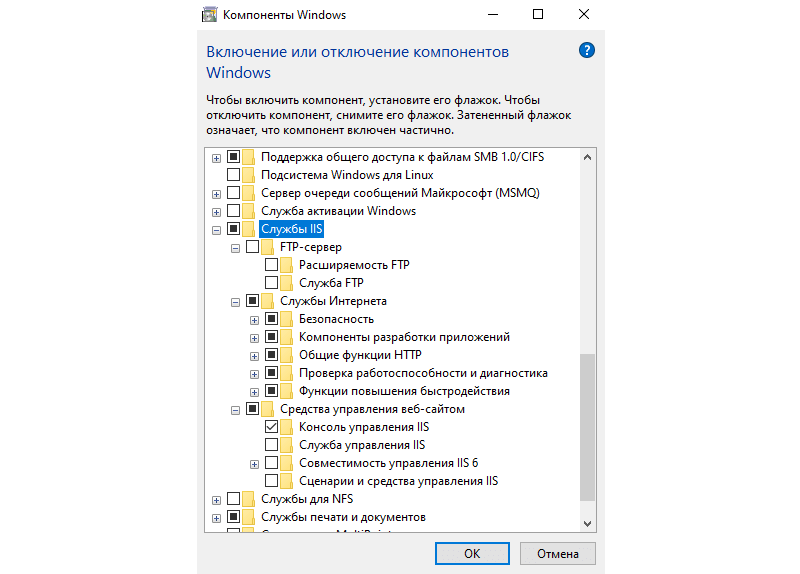
После того как все сделано можно запустить браузер, и вбить в адресной строке localhost, чтобы убедиться, что все работает. Также в меню Пуск и в папке «Средства администрирования» появится пункт «Диспетчер служб IIS». Также туда можно попасть снова нажав Win + R и набрав inetMgr.
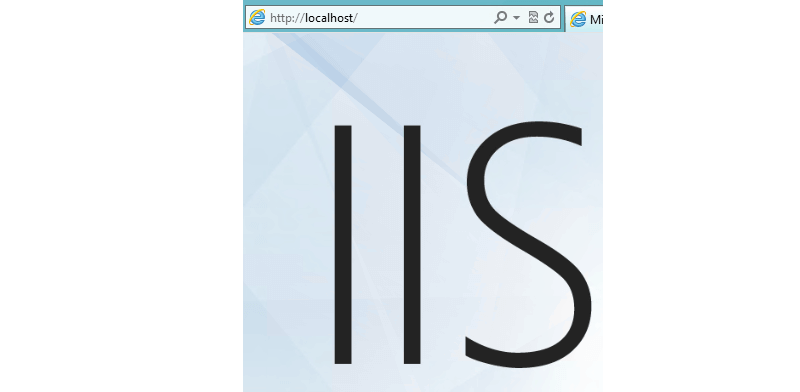
IIS (internet information services manager) on Windows 10/7 Desktop or server is basically a flexible and secure Web server provided by Microsoft on its desktop and server operating systems. Just like Apache and Nginx in Linux Distros on WIndows we have IIS.
Install and configure the webserver (IIS) in Windows 10Step 1: Enable Internet Information Services -IIS on Windows 10 Step 2: Start Internet information service (IIS) ManagerStep 3: Test IIS WebserverStep 4: Configure and install WordPress with IIS ManagerHow to Disable IIS web server on Windows 10
Install and configure the webserver (IIS) in Windows 10
Microsoft didn’t integrate only the desktop version of Windows with IIS- Internet Information Services instead with this even Windows 10 Home can be turned in to a web server with the help of this feature.
However, as compared free and open-source server such as Apache, the configuration and the dealing with IIS web server could be a little complex, yet if you are a Windows Desktop or server user, the usage of IIS would be best because of better integration into the system.
The IIS, which also contain an FTP server, is not intended on the client to provide company websites or heavily used web applications. The Windows 10 desktop IIS is mainly for developing or for the demonstration of web applications.
So, if you want to set up and run some application on Windows 10 PC using IIS, for example, WordPress, then here is the step by step guide to install and configure this web server.
Step 1: Enable Internet Information Services -IIS on Windows 10
So, to install the Windows 10 web server feature, we don’t have to download some special packages, it is already in our system and just we need to activate.
Go to Control panel-> Select Program-> Turn Windows features on and off.
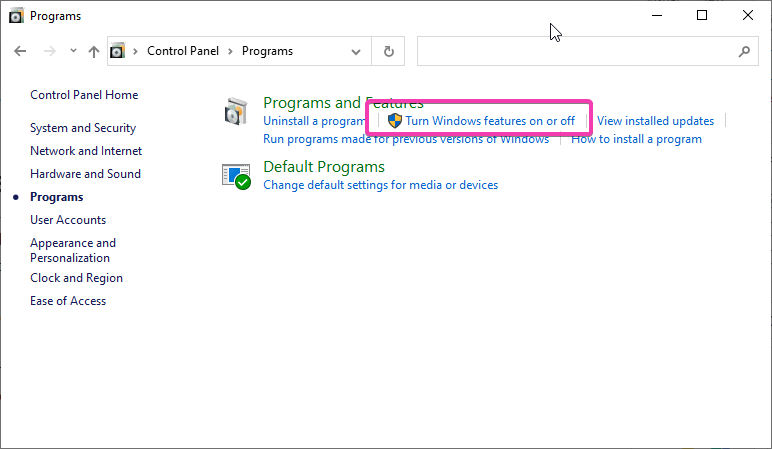
Now, scroll down and select “Internet Information Services” and press OK button to get it installed. Later restart the PC to make changes into effect.
The installation of it is very easy, by default when we select the IIS management console the Web Management Tools and Word Wide services along with HTTP features, performance features, security, system status and diagnostics are automatically going to be install. If you want FTP server as well then click on the + icon given in front of Internet information services and select FTP server option too.
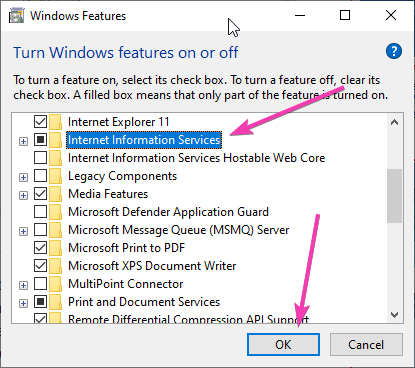
Step 2: Start Internet information service (IIS) Manager
Go to Windows 10 Search box and simply type IIS and you will get installed webserver Manager application, click on it to start.
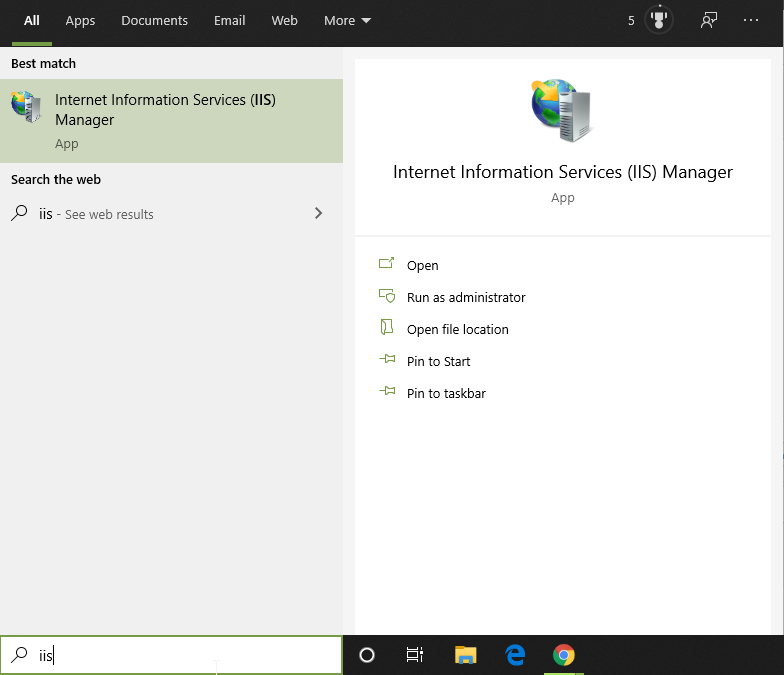
Finally, you will see the IIS manager with so many options to operate and handle different Web server application tasks.
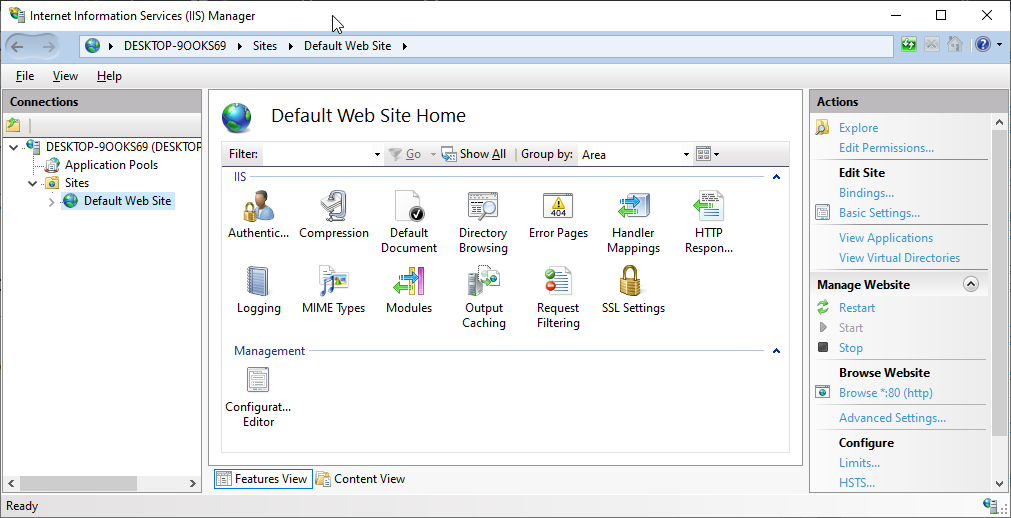
Step 3: Test IIS Webserver
After the installation of IIS, Windows will automatically start the webserver services on default port number 80. Thus, to check whether it is functioning properly or not, open your system browser and type http://localhost to see.
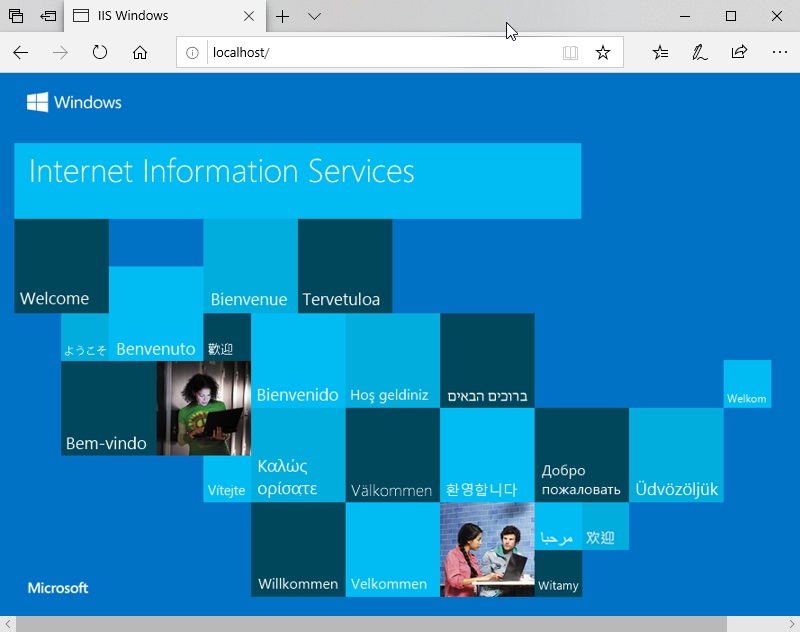
By default, the IIS shows the local HTML page to show everything is working fine. In case not then check whether the HTTP server (localhost) is listening on port 80. Run the following command in command prompt.
netstat -a -p tcp -n
However, for newly installed IIS webserver such problem would not appear.
In case, your port 80 is already bound to some other application then you can change the default website or Http listening port on IIS.
Right-click on Default web site option given under the Sites and select Edit Bindings.
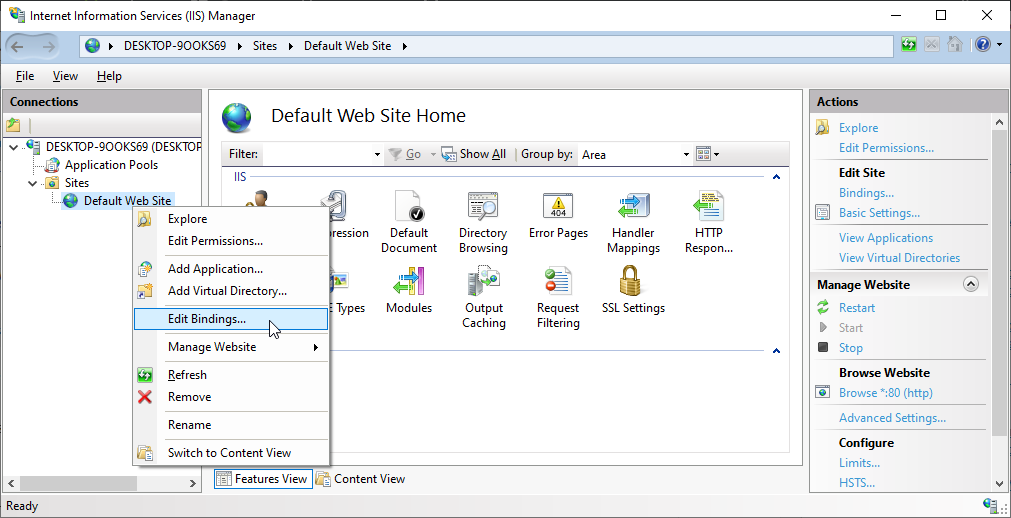
Now Click on Edit button and change the port number to one which you want to use. You can also specify any particular IP-address you want to use that port number.
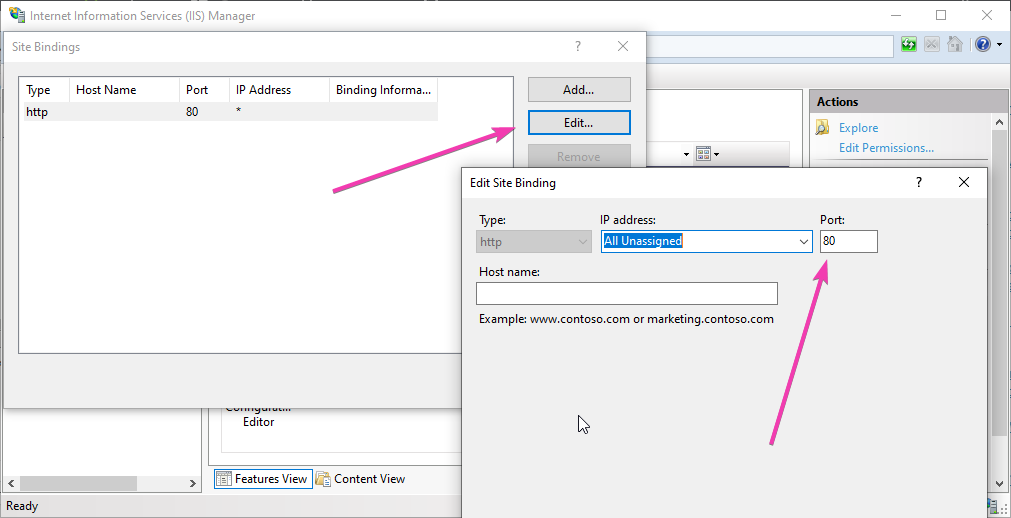
Step 4: Configure and install WordPress with IIS Manager
So, to give you an idea of how to host an HTML website or web application like WordPress on IIS, we are going to configure it.
However, hosting a website on IIS, the steps will be the same for both WordPress or just a simple HTML one. Yet being a web application WordPress needs PHP support too.
Right-click on the default website and select Explore.
The root directory at %SystemDrive% \inetpub\wwwroot will open. Now simply extract all your WordPress file there. If it asks for permission give it.
Now, Select your newly created website and click on the restart option given in the right-side panel.
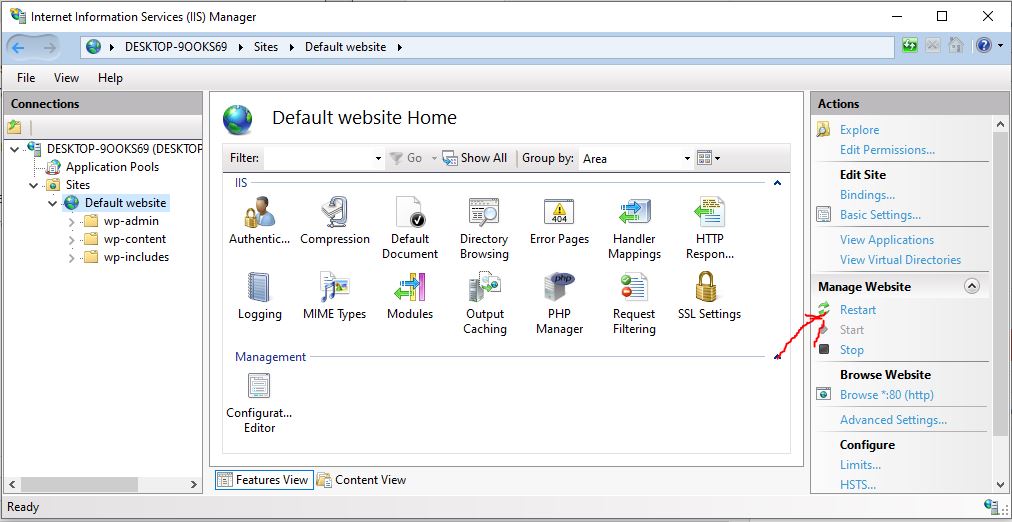
Add index.php to the Default Document.
Select Default website and double click on Default Document icon then Add link given on the right-side panel. Type index.php and save it.
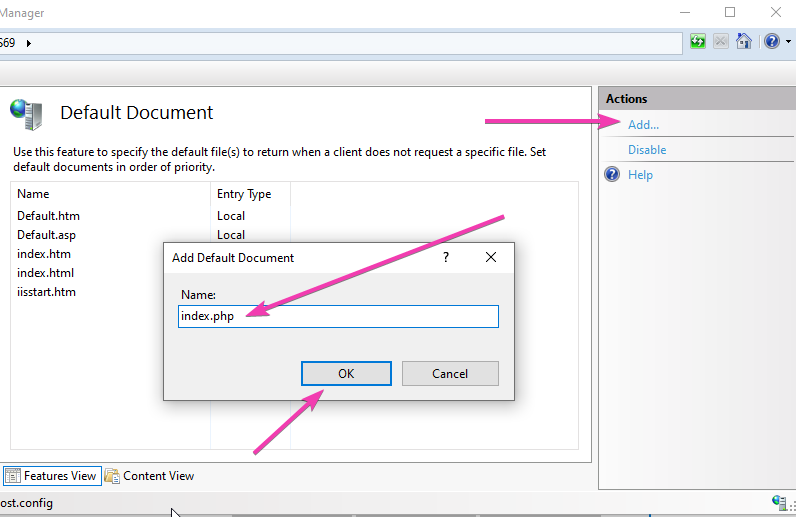
Open the browser and point it to http://localhost, this time it will show the hosted website. However, in case of WordPress, it gives an error because we haven’t yet configured its Wp-config file.
Again right-click on the Default website ->Explore and then rename wp-config-sample.php to wp-config.php.
Now edit the wp-config.php file and change the following things given in red colour… In short, add the database details.
// ** MySQL settings - You can get this info from your web host ** // /** The name of the database for WordPress */ define( 'DB_NAME', 'database_name_here' ); /** MySQL database username */ define( 'DB_USER', 'username_here' ); /** MySQL database password */ define( 'DB_PASSWORD', 'password_here' ); /** MySQL hostname */ define( 'DB_HOST', 'localhost' );
In case, it will say you don’t have permission to write a wp-config file, then simply right click on the Default website in IIS manager and select Edit Permissions.
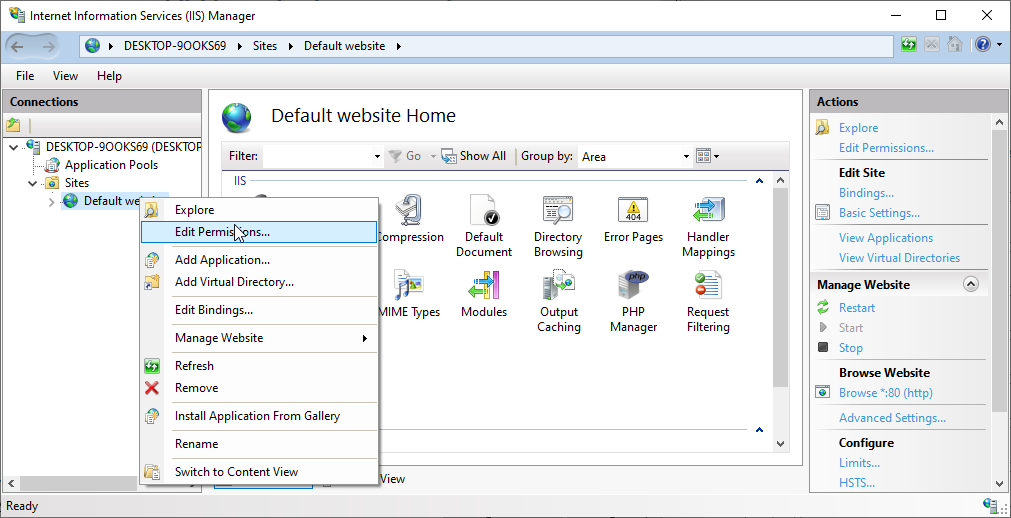
Go to Security Tab and select your Windows system user. Then Edit button-> Give all permissions to it and then press OK button.
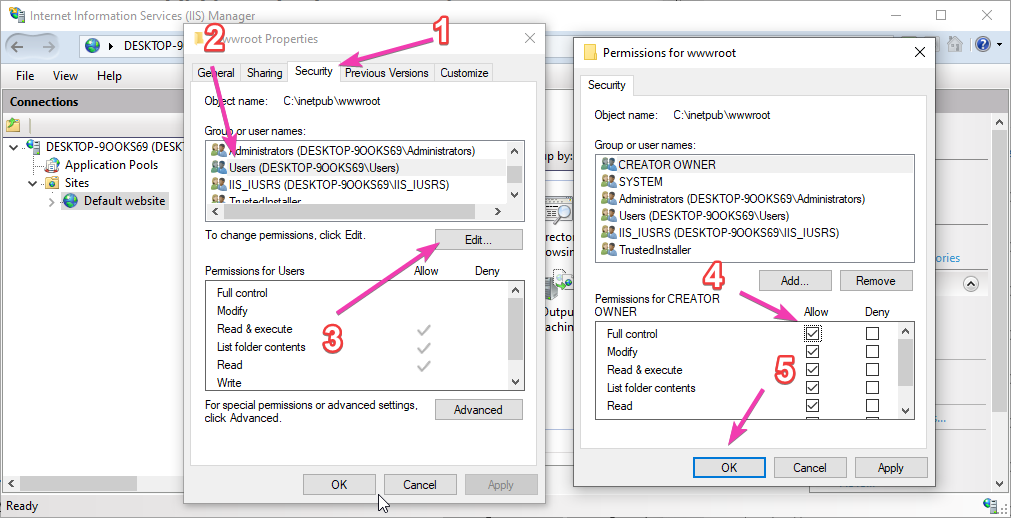
Now, type http://localhost/index.php and you would be able to access your WordPress installation.
In the same way, if you have hosted some HTML based website file for development in the root directory of Default website you will get to see that.
How to Disable IIS web server on Windows 10
In case you don’t require IIS Manager and want to disable it. Again open “Turn Windows feature On or OFF” and unselect the option “Internet Information Services“. This will remove the IIS web server from your Windows 10 or Windows 7 PC, laptop or server.

Other Articles:
- How to install Kali Linux with GUI on WSL Windows 10
- How to install Apache web server on CentOS 8 or Stream
- Install Apache Cassandra on Windows 10/8/7 without datastax
- How to install Apache, MySQL, PHP & PhpmyAdmin on Windows 10 WSL
Free Code / How to enable IIS on Windows 10
What Is IIS?
IIS is a Web Server software created by Microsoft, which is designed for hosting websites. It can be used in a standard Html page and dynamic pages like PHP pages and ASP.NET applications. To dig deeper into IIS’s definition and history, you can refer to Wikipedia.org for full details. To enable IIS on Windows 10, please follow the steps below.
- Internet Information Services (IIS) Manager
If you are working on a project and want to show your progress to one of your team members in a network, you might need to use IIS. You can configure IIS to share your work around the local network computer or on the internet
If you are trying to Host an ASP.NET Application visit this post How to Host ASP.NET Application in IIS.
Let’s Start:
- To enable IIS on Windows 10. Go to your control panel—search control panel from the start menu. Select the Control panel from the search result. Use the image below for your reference.
2. Alternative option would be to use the Run Command. You can search run from the start menu. Type the keyword Control Panel.
3. In the Control Panel Window select Uninstall program.
4. From the Installed Updates window click on the Turn Windows feature on or off link from the left pane.
5. Windows feature window should pop-up, scroll down, and search for Internet Information Services (IIS).Expand Internet Information Services and select option as shown in the image below.
6. Wait for windows to enable your Local IIS.
7. Verify if it is successfully enabled, go to the start menu and type IIS, and select Internet Information Services (IIS) as the image shown below.
Internet Information Services (IIS) Manager
You’re done! Your Internet Information Service or IIS is successfully enabled. You can now start hosting your ASP.Net Web Applications from your local IIS.
Also Visit:
Ipswitch Computer Repair
Northlakes PC Repair
AOVO PRO Electric Scooter Reviews
We use cookies on our website to give you the most relevant experience by remembering your preferences and repeat visits. By clicking “Accept”, you consent to the use of ALL the cookies.
- Author
- Recent Posts
I started writing code around 20 years ago, and throughout the years, I have gained a lot of expertise from hands-on experience as well as learning from others. This website has also grown with me and is now something that I am proud of.
Installing Internet Information Services (IIS) on Windows 10 might seem daunting at first, but it’s actually a straightforward process that enables you to host websites and applications directly on your PC. Whether you’re planning to use IIS for web development or to host a personal website, you’ll find that enabling and configuring this service can open up a world of possibilities for your online projects.

From my personal experience, I can say that once you’ve enabled IIS through the Control Panel, Command Line, or PowerShell, you’ll be ready to start hosting your own HTTPS-enabled websites. Imagine having your site up and running locally, making it easier to test and develop without extra complications. Enabling IIS gives you full control over your web server settings, making it a powerful tool for both novice and seasoned developers.
Moreover, configuring IIS allows you to set up a localhost environment, which is indispensable for testing new features before going live. Troubleshooting your own web server might sound tricky, but with IIS, you get extensive options to manage and configure settings easily. Starting and testing your first website through IIS is just a few steps away, making it an excellent choice for anyone serious about web development.
JUMP TO TOPIC
- Setting Up Your Windows Environment for IIS
- Understanding Windows Features Related to IIS
- Navigating the Control Panel and Using ‘Turn Windows Features on or Off’
- The Installation Process of IIS
- Using the GUI for IIS Setup
- Command Line Methods: DISM and PowerShell
- Configuring IIS
- Setting Up Websites and Application Pools
- Security Features and Protocols Configuration
- Performance Monitoring and Diagnostics Tools
- Hosting Web Applications on IIS
- Deploying ASP.NET and PHP Applications
- Integrating with Databases and Setting Up WordPress
- Managing the Default Website and Custom Web Pages
Setting Up Your Windows Environment for IIS
To install IIS on Windows 10, you need to configure your system correctly. Follow these steps to ensure that your environment is properly set up and ready for IIS.
Understanding Windows Features Related to IIS
Windows 10 includes several features that are essential for IIS. These “Windows Features” must be enabled to run IIS smoothly.
I start by checking the installed operating system. This varies slightly between Windows 8, Windows 10, and Windows Server 2012. Once verified, I proceed to the “Programs and Features” section.
Essential Windows Features for IIS:
- Internet Information Services
- Web Management Tools
- World Wide Web Services
- Application Development Features
- Common HTTP Features
These components are integral to the functionality of IIS. Without them, running a web server on your Windows operating system will be problematic.
Navigating the Control Panel and Using ‘Turn Windows Features on or Off’
Access “Turn Windows Features on or off” from the Control Panel. This is your hub for enabling and disabling optional features in your operating system.
I start by opening the Control Panel. This can be done by searching “Control Panel” in the Start menu. Once inside, I navigate to “Programs and Features”. Here I find “Turn Windows Features on or off.”
In the window that appears, I must ensure all necessary IIS components are checked.
| Feature | Description |
| Internet Information Services | The primary web server feature for hosting websites. |
| Web Management Tools | Tools for managing your IIS server. |
| World Wide Web Services | Essential for running websites and web applications. |
| Application Development Features | Supports development frameworks like .NET. |
| Common HTTP Features | Fundamental HTTP support for websites. |
After selecting the desired features, I click “OK” to install them. Windows will configure and install these components automatically.
Ensuring these steps are followed precisely means your Windows environment will be ready for IIS installation and configuration.
The Installation Process of IIS
Installing Internet Information Services (IIS) in Windows 10 can be done using different approaches. These include the graphical user interface (GUI) and command line methods such as DISM and PowerShell. Each method has its advantages, making it suitable for different user preferences.
Using the GUI for IIS Setup
To install IIS using the GUI, start by opening Control Panel from the Windows search bar. Once opened, make sure the View by option is set to Category. This setting makes navigation easier.
Next, select Programs followed by Turn Windows features on or off. In the window that appears, scroll down and check the box next to Internet Information Services. Clicking OK will start the installation process.
After installation, open IIS Manager by typing inetmgr in the Windows search bar. Here, you can manage sites, configure applications, and monitor performance.
Command Line Methods: DISM and PowerShell
For more control, you might prefer using command line tools like DISM and PowerShell. With DISM, open an elevated Command Prompt and type:
DISM /Online /Enable-Feature /FeatureName:IIS-DefaultDocument
This command starts installing IIS and any related features.
Alternatively, using PowerShell can simplify the process. Open a PowerShell window with administrative privileges and use:
Enable-WindowsOptionalFeature -Online -FeatureName IIS-WebServerRole
PowerShell’s flexibility also allows you to script multiple configurations at once, saving time for repeated setups.
Both methods require administrative rights and complete quickly, adding IIS to your system without the need for interactive dialogs.
Configuring IIS
Configuring IIS ensures optimal performance and security for your web server. It involves setting up websites and application pools, configuring security features, and utilizing performance monitoring tools.
Setting Up Websites and Application Pools
To set up a website in IIS:
- Open IIS Manager by typing
inetmgrin the search bar. - Navigate to the Sites folder, right-click, and select Add Website.
- Enter a name for your site in the Site name field.
- Set the Physical path to your website’s directory.
- Configure the Binding section to use
HTTPand set the IP address toAll Unassigned.
Creating and managing Application Pools is crucial for isolating different web applications. This helps in enhancing security and optimizing resource usage.
- In IIS Manager, go to Application Pools.
- Click Add Application Pool.
- Name the pool and choose the .NET CLR version.
- Ensure Start application pool immediately is checked.
Security Features and Protocols Configuration
Configuring security in IIS involves setting up protocols like SSL for secure communication and adjusting permissions to control access.
- To enable SSL, purchase and install an SSL certificate.
- Open IIS Manager, select your site, and click Bindings.
- Add an HTTPS binding, select the appropriate SSL certificate, and apply.
Additionally, FTP can be secured with FTPS:
- Install the FTP server role in IIS.
- Configure an FTP site and enable FTP over SSL (FTPS).
Permissions are critical in securing your server:
- In IIS Manager under your site, select Edit Permissions.
- Adjust the security settings under the Security tab by adding or restricting user access appropriately.
Performance Monitoring and Diagnostics Tools
Monitoring performance and diagnosing issues are key components in maintaining a healthy IIS environment.
Use the IIS Manager built-in tools for performance monitoring:
- Open IIS Manager and select your website.
- Under Manage Website, click Advanced Settings to review performance settings.
For detailed diagnostics:
- Use Failed Request Tracing in IIS to log detailed failure information.
- Enable Logging to monitor HTTP transactions.
Windows Performance Monitor provides real-time data and includes a variety of counters to track server performance:
- Type
perfmonin the search bar to open Performance Monitor. - Add counters related to IIS, such as Processor Time and Bytes Sent/sec.
These tools ensure that you can proactively manage and troubleshoot your IIS installations efficiently.
Hosting Web Applications on IIS
Hosting web applications on IIS involves deploying applications, integrating database services, and managing websites to ensure seamless access and functionality.
Deploying ASP.NET and PHP Applications
Deploying ASP.NET applications on IIS is straightforward. First, I ensure the IIS installation is complete and the ASP.NET modules are enabled. I use the Solution Explorer in Visual Studio to publish my application.
PHP applications are also easy to deploy. I usually install the PHP module for IIS, configure the relevant .ini files, and copy the PHP application files to the wwwroot directory. Then, I set appropriate handler mappings.
Key steps:
- Install relevant modules (ASP.NET or PHP)
- Publish and configure applications
- Set handler mappings and permissions
Integrating with Databases and Setting Up WordPress
Integrating databases with IIS-hosted applications is crucial for dynamic websites. For ASP.NET, I configure connection strings to my SQL Server database in the web.config file. In PHP, I primarily work with MySQL, editing the config.php file.
Setting up WordPress involves creating a MySQL database, downloading WordPress, and placing files in wwwroot. I run the WordPress installer via browser, follow the setup steps, and ensure the wp-content directory has writable permissions.
Important points:
- Database configuration in application files
- MySQL or SQL Server integration
- WordPress installation and setup
Managing the Default Website and Custom Web Pages
Managing the IIS Default Web Site and custom web pages includes configuring settings, managing bindings, and creating virtual directories. I modify the physical path of the Default Web Site to point to my application’s directory.
I use bindings to assign the site to specific IP addresses or hostnames. Creating virtual directories allows me to host multiple applications under one domain. Using SSL/TLS certificates ensures secure HTTPS access.
Steps include:
- Modify physical path
- Set up bindings and SSL certificates
- Create virtual directories for multiple apps
Handling the Default Web Site and custom web pages ensures a tailored, secure, and efficient hosting environment on IIS.
